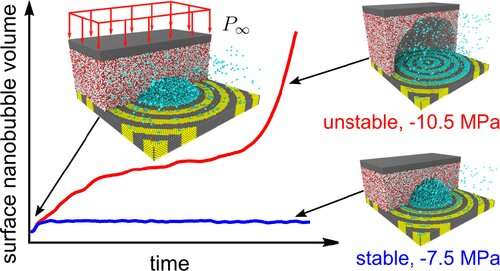Credit: ACS
Insights into how minute, yet powerful, bubbles form and collapse on underwater surfaces could help make industrial structures such as ship propellers more hardwearing, research suggests.
Supercomputer calculations have revealed details of the growth of so-called nanobubbles, which are tens of thousands of times smaller than a pin head.
The findings could lend valuable insight into damage caused on industrial structures, such as pump components, when these bubbles burst to release tiny but powerful jets of liquid.
This rapid expansion and collapse of bubbles, known as cavitation, is a common problem in engineering but is not well understood.
Engineers at the University of Edinburgh devised complex simulations of air bubbles in water, using the UK's national supercomputer.
The team modelled the motion of atoms in the bubbles and observed how they grew in response to small drops in water pressure.
They were able to determine the critical pressure needed for bubble growth to become unstable, and found that this was much lower than suggested by theory.
Their findings could inform the development of nanotechnologies to harness the power of thousands of jets from collapsing nanobubbles, such as therapies to target some cancers, or for cleaning high-precision technical equipment. Researchers have proposed an updated theory on the stability of surface nanobubbles, based on their findings.
Their study, published in Langmuir, was supported by the Engineering and Physical Sciences Research Council.
Duncan Dockar, of the University of Edinburgh's School of Engineering, said: "Bubbles routinely form and burst on surfaces that move through fluids and the resulting wear can cause drag and critical damage. We hope our insights, made possible with complex computing, can help limit the impact on machine performance and enable future technologies."
More information: Duncan Dockar et al, Mechanical Stability of Surface Nanobubbles, Langmuir (2018). DOI: 10.1021/acs.langmuir.8b02887
Journal information: Langmuir
Provided by University of Edinburgh























